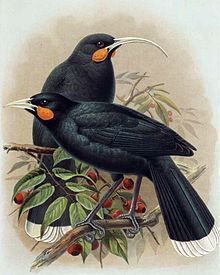Order Passeriformes Higher classification Songbirds | Phylum Chordata Suborder Passeri Rank Family | |
 | ||
Similar Bird, New Zealand wren, Passerine, Australasian treecreeper, Australian mudnester | ||
The small bird family Callaeidae (also named in some sources as Callaeatidae) is endemic to New Zealand. It contains three monotypic genera, with five species in the family. One, the huia, became extinct early in the 20th century.
The Callaeidae are often known as wattlebirds, a term that leads to confusion, as there are other, unrelated species with this same name, notably the large Australian wattlebirds of the family Meliphagidae, which are honeyeaters. For this reason New Zealand wattlebirds is the informal name for this family used by the scientific community. Equally confusingly, they are also sometimes known as wattled crows, even though they are not corvids and are only distantly related to crows.
Biology and evolution
They are ground-dwelling songbirds, 26–38 cm in length. They inhabit dense forests, where they feed on insects. They have strong legs and featherless wattles behind the bill. Their wings are rounded and unusually weak, giving them very limited powers of flight. They are monogamous and maintain permanent territories.
These birds seem to be remnants of an early expansion of passerines to New Zealand. They have no close relatives except the stitchbird, and their more distant relationships are likewise still unknown.
A molecular study of the nuclear RAG-1 and c-mos genes of the three species within the family proved inconclusive, the data providing most support for either a basally diverging kokako or huia.
